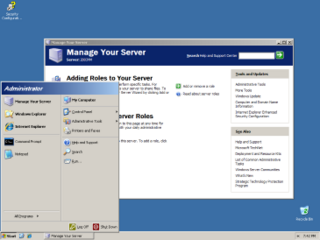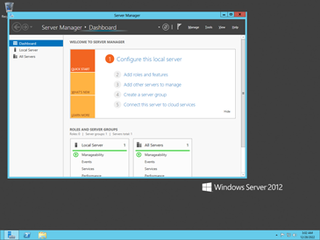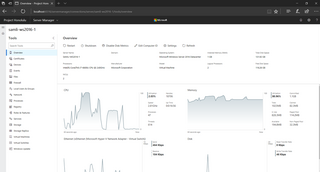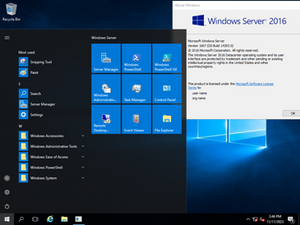Active Directory (AD) is a directory service developed by Microsoft for Windows domain networks. Windows Server operating systems include it as a set of processes and services. Originally, only centralized domain management used Active Directory. However, it ultimately became an umbrella title for various directory-based identity-related services.
Microsoft Windows is a product line of proprietary graphical operating systems developed and marketed by Microsoft. It is grouped into families and sub-families that cater to particular sectors of the computing industry -- Windows (unqualified) for a consumer or corporate workstation, Windows Server for a server and Windows IoT for an embedded system. Defunct families include Windows 9x, Windows Mobile, Windows Phone, and Windows Embedded Compact.

Windows Server 2003, codenamed "Whistler Server", is the sixth version of the Windows Server operating system produced by Microsoft. It is part of the Windows NT family of operating systems and was released to manufacturing on March 28, 2003 and generally available on April 24, 2003. Windows Server 2003 is the successor to the Server editions of Windows 2000 and the predecessor to Windows Server 2008. An updated version, Windows Server 2003 R2, was released to manufacturing on December 6, 2005. Windows Server 2003 is based on Windows XP.
Virtual PC is an x86 emulator for PowerPC Mac hosts and a virtualization app for Microsoft Windows hosts. It was created by Connectix in 1997 and acquired by Microsoft in 2003. The Mac version was discontinued in 2006 following the Mac transition to Intel, while the Windows version was discontinued in 2011 in favour of Hyper-V.
Remote Desktop Protocol (RDP) is a proprietary protocol developed by Microsoft Corporation which provides a user with a graphical interface to connect to another computer over a network connection. The user employs RDP client software for this purpose, while the other computer must run RDP server software.
Windows Server is a group of server operating systems (OS) that has been developed by Microsoft since 1993. The first OS that was released for this platform is Windows NT 3.1 Advanced Server, an edition of Windows NT 3.1. With the release of Windows Server 2003, Microsoft started releasing new versions under the name Windows Server. The latest release of Windows Server is Windows Server 2022, which was released in 2021.

Windows Server 2008, codenamed "Longhorn Server", is the seventh release of the Windows Server operating system produced by Microsoft as part of the Windows NT family of the operating systems. It was released to manufacturing on February 4, 2008, and generally to retail on February 27, 2008. Derived from Windows Vista, Windows Server 2008 is the successor of Windows Server 2003 and the predecessor to Windows Server 2008 R2.

Microsoft Hyper-V, codenamed Viridian, and briefly known before its release as Windows Server Virtualization, is a native hypervisor; it can create virtual machines on x86-64 systems running Windows. Starting with Windows 8, Hyper-V superseded Windows Virtual PC as the hardware virtualization component of the client editions of Windows NT. A server computer running Hyper-V can be configured to expose individual virtual machines to one or more networks. Hyper-V was first released with Windows Server 2008, and has been available without additional charge since Windows Server 2012 and Windows 8. A standalone Windows Hyper-V Server is free, but has a command-line interface only. The last version of free Hyper-V Server is Hyper-V Server 2019, which is based on Windows Server 2019.

Windows Server 2008 R2, codenamed "Windows Server 7", is the eighth version of the Windows Server operating system produced by Microsoft and released as part of the Windows NT family of operating systems. It was released to manufacturing on July 22, 2009, and became generally available on October 22, 2009, shortly after the completion of Windows 7. It is the successor to Windows Server 2008, which is derived from the Windows Vista codebase, released the previous year, and was succeeded by the Windows 8-based Windows Server 2012.
Some of the new features included in Windows 7 are advancements in touch, speech and handwriting recognition, support for virtual hard disks, support for additional file formats, improved performance on multi-core processors, improved boot performance, and kernel improvements.
Microsoft RemoteFX is a Microsoft brand name that covers a set of technologies that enhance visual experience of the Microsoft-developed remote display protocol Remote Desktop Protocol (RDP). RemoteFX was first introduced in Windows Server 2008 R2 SP1 and is based on intellectual property that Microsoft acquired and continued to develop since acquiring Calista Technologies. It is a part of the overall Remote Desktop Services workload.
Resilient File System (ReFS), codenamed "Protogon", is a Microsoft proprietary file system introduced with Windows Server 2012 with the intent of becoming the "next generation" file system after NTFS.

Windows Server 2012, codenamed "Windows Server 8", is the ninth version of the Windows Server operating system by Microsoft, as part of the Windows NT family of operating systems. It is the server version of Windows based on Windows 8 and succeeds Windows Server 2008 R2, which is derived from the Windows 7 codebase, released nearly three years earlier. Two pre-release versions, a developer preview and a beta version, were released during development. The software was officially launched on September 4, 2012, which was the month before the release of Windows 8. It was succeeded by Windows Server 2012 R2 in 2013. Mainstream support for Windows Server 2012 ended on October 9, 2018, and extended support ended on October 10, 2023. Windows Server 2012 is eligible for the paid Extended Security Updates (ESU) program, which offers continued security updates until October 13, 2026.
Server Core is a minimalistic Microsoft Windows Server installation option, debuted in Windows Server 2008. Server Core provides a server environment with functionality scaled back to core server features, and because of limited features, it has reduced servicing and management requirements, attack surface, disk and memory usage. Andrew Mason, a program manager on the Windows Server team, noted that a primary motivation for producing a Server Core variant of Windows Server 2008 was to reduce the attack surface of the operating system, and that about 70% of the security vulnerabilities in Microsoft Windows from the prior five years would not have affected Server Core. Most notably, no Windows Explorer shell is installed. All configuration and maintenance is done entirely through command-line interface windows, or by connecting to the machine remotely using Microsoft Management Console (MMC), remote server administration tools, and PowerShell.

Windows Server 2012 R2, codenamed "Windows Server Blue", is the tenth version of the Windows Server operating system by Microsoft, as part of the Windows NT family of operating systems. It was unveiled on June 3, 2013, at TechEd North America, and released on October 18 of the same year. It is the successor to Windows Server 2012, and is based on the Windows 8.1 codebase.
Docker is a set of platform as a service (PaaS) products that use OS-level virtualization to deliver software in packages called containers. The service has both free and premium tiers. The software that hosts the containers is called Docker Engine. It was first released in 2013 and is developed by Docker, Inc.

Windows Subsystem for Linux (WSL) is a feature of Microsoft Windows that allows developers to run a Linux environment without the need for a separate virtual machine or dual booting. There are two versions of WSL: WSL 1 and WSL 2. WSL is not available to all Windows 10 users by default. It can be installed either by joining the Windows Insider program or manually via Microsoft Store or Winget.

MSP360, formerly CloudBerry Lab, is a software and application service provider company that develops online backup, remote desktop and file management products integrated with more than 20 cloud storage providers.

Windows Admin Center is a web program released by Microsoft on April 12, 2018 as an evolution of the Windows Server graphical user interface (GUI). Officially launched in public preview under the code name Project Honolulu at the Microsoft Ignite 2017 conference in Orlando, Florida, Windows Admin Center is meant to be a GUI-focused replacement for the management of Windows servers, Windows server clusters, and PCs. The idea behind the project was to simplify the management of servers by placing the majority of frequently referenced tools used by system administrators in one place. The project left preview on April 12, 2018 and was named Windows Admin Center.

Windows Server 2019 is the twelfth version of the Windows Server operating system by Microsoft, as part of the Windows NT family of operating systems. It is the second version of the server operating system based on the Windows 10 platform, after Windows Server 2016. It was announced on March 20, 2018 for the first Windows Insider preview release, and was released internationally on October 2, 2018. It was succeeded by Windows Server 2022 on August 18, 2021.










